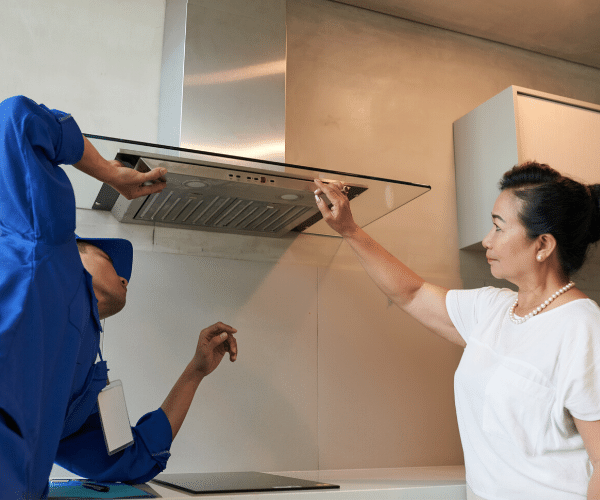A kitchen hood is an essential appliance for any kitchen, as it helps to remove smoke, odors, and grease from the air while cooking. However, in order for it to function properly, it needs to be vented to the outside of the house. While some kitchen hoods can be vented through the ceiling, many homeowners prefer to vent them through the wall for a more seamless and discreet look. If you're considering venting your kitchen hood through the wall, here's everything you need to know.How to Vent a Kitchen Hood Through the Wall
The first step in venting a kitchen hood through the wall is to determine the best location for the vent. It should be placed above the cooking surface and away from any windows or doors. Once you have chosen the location, you will need to cut a hole in the wall for the vent. This can be done with a jigsaw or reciprocating saw. Make sure to measure and mark the hole accurately before cutting.Installing a Kitchen Hood Vent Through the Wall
To properly vent your kitchen hood through the wall, follow these steps:Step-by-Step Guide for Venting a Kitchen Hood Through the Wall
When it comes to venting a kitchen hood through the wall, there are a few options for the type of venting system you can use. The most common are ducted and ductless vents. Ducted vents use a duct to expel the air outside, while ductless vents use a filter to trap grease and odors before recirculating the air back into the kitchen. Ducted vents are generally considered more effective, but ductless vents can be a good option for homes without access to an exterior wall.Choosing the Right Venting System for Your Kitchen Hood
While venting a kitchen hood through the wall may seem like a straightforward process, there are some common mistakes that homeowners make that can lead to issues down the line. These include:Common Mistakes to Avoid When Venting a Kitchen Hood Through the Wall
Before starting the installation process, make sure you have all the necessary tools and materials on hand. These may include:Tools and Materials Needed for Venting a Kitchen Hood Through the Wall
Properly sealing the vent in the wall is crucial for ensuring efficient ventilation and preventing air leaks. Here are a few tips to keep in mind:Tips for Properly Sealing the Vent in the Wall for a Kitchen Hood
The best location for venting a kitchen hood through the wall will depend on the layout of your kitchen and the placement of your cooking surface. Generally, it's best to place the vent directly above the cooking surface, but make sure to also consider any windows or doors in the area. You want to avoid placing the vent too close to these openings to prevent any outdoor air from coming in while cooking.How to Determine the Best Location for Venting a Kitchen Hood Through the Wall
Venting a kitchen hood through the wall offers several benefits, including:Benefits of Venting a Kitchen Hood Through the Wall
While venting a kitchen hood through the wall can be done as a DIY project, it may be best to hire a professional for the installation. A professional will have the necessary skills and experience to ensure proper installation and can also advise on the best location and type of venting system for your specific kitchen. Additionally, a professional installation may be required to comply with building codes and regulations in your area.Professional Installation vs. DIY for Venting a Kitchen Hood Through the Wall
Why Venting Your Kitchen Hood Through the Wall is a Smart Design Choice

When it comes to designing your dream kitchen, every detail matters. From the layout to the finishes, every decision impacts the functionality and overall aesthetic of the space. One key element that often gets overlooked is the placement of the kitchen hood. While many homeowners opt for a traditional ceiling-mounted hood, venting it through the wall can offer several benefits that not only enhance the design but also improve the functionality of your kitchen.
Maximizing Space

In smaller kitchens, space is always at a premium. By venting your kitchen hood through the wall, you can free up valuable ceiling space for other design elements such as pendant lighting or a decorative ceiling feature. This can also create a more open and spacious feel in the kitchen, making it the perfect gathering spot for family and friends.
Efficient Ventilation

Another advantage of venting your kitchen hood through the wall is that it offers more efficient ventilation. With a ceiling-mounted hood, heat and smoke tend to rise and can get trapped in the corners of the room. By venting through the wall, the hood can capture smoke and cooking odors at their source, ensuring better air circulation and a fresher smelling kitchen.
Design Flexibility
Venting your kitchen hood through the wall also allows for more design flexibility. You can choose to have the vent located directly behind the hood, or you can opt for a concealed vent that blends seamlessly into the surrounding cabinetry. This gives you more options for creating a cohesive and visually appealing design in your kitchen.
Cost-Effective

Finally, venting your kitchen hood through the wall can be a more cost-effective option. Installing a ceiling-mounted hood often requires additional structural support and can be more labor-intensive, resulting in higher installation costs. By venting through the wall, you can save on these expenses and still achieve the same level of ventilation and functionality.
In conclusion, venting your kitchen hood through the wall is a smart design choice that offers numerous benefits. From maximizing space to improving ventilation and offering design flexibility, this option is worth considering in your kitchen design plans. So, before making a final decision on your kitchen hood placement, be sure to give venting through the wall some serious consideration.







/cdn.vox-cdn.com/uploads/chorus_asset/file/19498652/range_vent_hood_xl.jpg)



























































